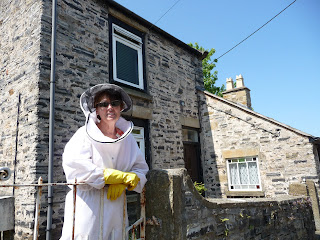Thom, Sheila, Janet, Daniel, and Stuart arrive at Talacre Beach.
Here are the three cyclists who will be peddling from San Diego, California, to Key West, Florida, in October/November 2012. They are allowing 70 days, but hope to complete the coast to coast ride in 60 days. They are Thom Winkelspecht, whom most of you already know, and his brother-in-law Stuart (pictured right), who is also an Air Traffic Controller and a retired military ATC like Thom.
Thom served in the USAF; Stuart served in the Royal Air Force, being based in Cornwall, Gibraltar, Wiltshire, Germany and Scotland. Stuart is married to Sheila's sister, Janet; Stu and Jan have a daughter and son. Their daughter Sandra, a former RAF navigator on a Nimrod (a maritime patrol aircraft), is presently living with her family in San Diego. Her husband, RAF Squadron Leader and pilot John Butcher, is on an exchange tour with the US Marines at Miramar.
Their son, 26-year-old Daniel, is the third cyclist! Dan graduated from London University, Imperial College, and is a financial adviser for an international company. He recently cycled from London to Paris in four days.
The cyclists will be raising money for Help for Heroes/Wounded Warriors during their bike ride.
|






















1 comment:
My name is Liz and I’m contacting you from Silver River Productions, a TV company based in London. We are currently in production for a BBC2 primetime gardening show ‘The Big Allotment Challenge.’
The series follows a handful of talented amateur kitchen gardeners as they transform a plot of earth in our walled garden into a patch of beauty and reveal all the wonderful possibilities that can be unlocked from allotment growing.
We are looking for contestants to feature in the series, those who have the skill and dedication and who could dig their way to victory and be crowned the winner of ‘The Big Allotment Challenge.’ People who can cultivate the perfect carrot, make their green tomatoes into tasty chutney and turn their dahlias and sweet peas into floral arrangements.
So whether you’re an allotmenteer, a city living window box grower, or a gardening enthusiast, we want to hear from you. We are coming to the end of our application process so email grow@silverriver.tv for an application form today!
Post a Comment